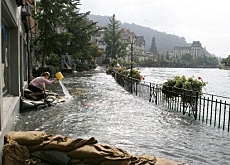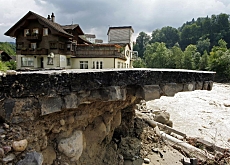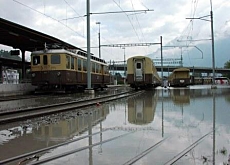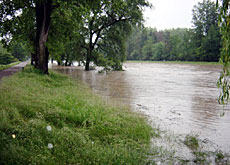Criticism stirs up flood waters

The Swiss authorities are facing mounting criticism that they could have done more to prevent the flooding and ensuing damage.
The United Nations disaster reduction agency said warnings were inadequate, while the WWF Switzerland said the practice of forcing rivers into “straitjackets” had made flooding more likely.
Most cantons have failed to take any action since 1991 when a federal hydraulic engineering law was introduced demanding the introduction of measures to prevent flooding.
The 14-year-old law states cantons are to do whatever is necessary to protect their communities, including the widening of riverbeds and the building of dams and reservoirs.
It adds that wherever possible, natural river courses should be maintained or reinstated to the way they once were.
On Wednesday the Geneva-based International Strategy for Disaster Reduction said there would have been fewer flood victims if people had been given sufficient warning.
“We don’t understand why a country as highly developed as Switzerland, and with a lot of experience with flooding, did not do things better,” Salvano Briceno, director of the United Nations agency, told swissinfo.
Missing link
Briceno said the early warning system had obviously failed, saying there must have been a “missing link in the chain of communication”.
He also said scenes of houses being swept away by floodwaters were clear evidence that “land-use legislation was not being implemented fully”.
The Swiss branch of the World Wide Fund For Nature (WWF) said it was the failure of the Swiss authorities to follow the letter of the law that had exacerbated the flooding.
“The current high water in Switzerland once again underlines the importance of giving rivers and streams enough room,” the WWF said in a statement. “The long-standing practice to force rivers into a narrow straitjacket has failed.”
The harshest criticism was levelled at the authorities in canton Bern.
Alexander Tschäppät, the mayor of the city of Bern, where the lower section of the old town was heavily flooded, joined the chorus. He placed the lion’s share of the blame on the canton for moving too slowly.
But the cantonal minister responsible for flood protection, Barbara Egger, rejected the accusation in an interview with German language radio.
“We’ve done everything we could over the past six years, considering the fact that we’ve had to take the interests of various groups into account,” she said.
She added that the canton did not have sufficient financial resources or personnel to deal with a disaster of this magnitude.
Fishing rights
Since the last major flood in 1999, the city of Bern has had to postpone plans to dredge the River Aare after the project was torpedoed by different groups, including hobby fishermen.
Tschäppät asked rhetorically whether defending spawning grounds was more important than protecting residents and their property.
But the city of Bern is largely at the mercy of the towns and villages situated upstream on the banks of the River Aare between Thun and the Swiss capital.
Residents of at least three communities said no in 2000 to a first proposal to widen the bed of the River Aare to increase its capacity and prevent flooding.
They sent the authorities back to the drawing board and a new project will not be completed before 2007, if at all.
River corrections
The latest version of the “river corrections” is being fought by an outspoken member of Bern’s city council, Kurt Wasserfallen, who, according to Der Bund newspaper, will lose his favourite riverside walking trail if the plan goes ahead.
Ernst Spycher, the hydraulic engineer responsible for the flood protection project for Lake Thun, told swissinfo that a planned pipeline to redirect floodwater under Thun and other proposed measures could have halved the damage caused by the disastrous flood of 1999.
Spycher said it was still too early to tell what, if any, effect the pipeline would have had this time round.
However, he rejected accusations that the canton has been dragging its feet. “In my opinion, we’ve moved very quickly. Immediately after the 1999 flood, we began looking into ways to prevent a repeat.”
Complex
Spycher said the situation was extremely complex, with the different physical, geo-morphological and hydraulic conditions in the different parts of the River Aare having to be taken into account.
Peter Volkart, head of the Hydraulics Laboratory at the Federal Institute of Technology in Zurich, cautioned that there are no quick fixes concerning Lake Thun and Lake Brienz, which both run into the River Aare.
“The lakes are not dams, so you can’t artificially regulate the water level very much,” he told swissinfo, adding that there was a fine line between a normal water level and flood conditions.
Volkart said various measures to protect against flooding had been tabled since the late 1980s, but they had run into opposition from environmentalists, fishermen, homeowners and conservators.
However, both he and Spycher expressed optimism that the building of the pipeline would now go ahead and be completed by 2007.
swissinfo, Dale Bechtel
The Swiss hydraulic engineering law from 1991 is aimed at protecting people and property from flooding and landslides.
Each canton is responsible for implementing the law by maintaining its waterways and through land-use planning measures.
The Swiss government is obliged to commit funding for flood protection projects if needed.

In compliance with the JTI standards
More: SWI swissinfo.ch certified by the Journalism Trust Initiative




You can find an overview of ongoing debates with our journalists here. Please join us!
If you want to start a conversation about a topic raised in this article or want to report factual errors, email us at english@swissinfo.ch.